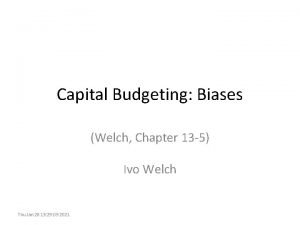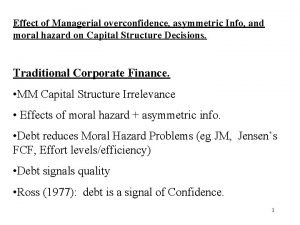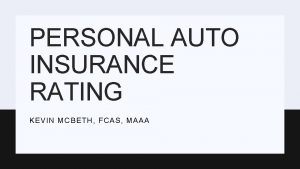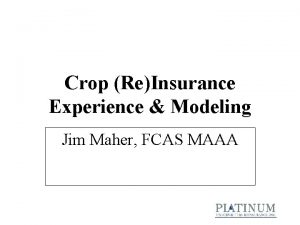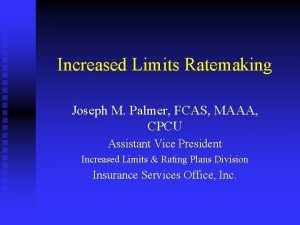Managing Overconfidence Douglas J Collins FCAS MAAA doug






- Slides: 6

Managing Overconfidence Douglas J. Collins, FCAS, MAAA doug. collins@towersperrin. com Tillinghast London (Tel: 44 (0)207 170 2162) CAE Zurich – 23 April 2004

Many factors contribute to errors (and bias!) in pricing and underwriting Common Sources of Pricing and Underwriting Error/Bias (Micro) n Inadequate internal [historical] data upon which to develop estimates (e. g. , old, incomplete or inaccurate data; inadequate/inappropriate sample) Systemic Sources of Pricing and Underwriting Error/Bias (Macro) n Long feedback loop n No skin in the game n Inability to collect and synthesize all relevant sources of data within the organization n Lack of reliable information about external market conditions and trends (e. g. , inflation, tort costs) n Excessive concern for “competitive pressures” n Lack of adequate oversight over pricing decisions n Lack of “metaknowledge” — reinforces inherent overconfidence when making estimates, forecasts and predictions © Copyright Towers, Perrin, Forster & Crosby, Inc 2

The results of a recent Tillinghast “Confidence Quiz” illustrate the prevalence of overconfidence Tillinghast Confidence Quiz The Quiz n Objective: To test respondents understanding of the limits of their knowledge Raw Scores of Online Respondents Number of Respondents n Respondents were asked to answer ten questions related to their general knowledge of the global property/casualty industry n For each answer, respondents were asked to provide a range that offered a 90% confidence interval that they would answer correctly n Ideally (i. e. , if “well calibrated”), respondents should have gotten nine out of ten questions correct Note: based on 374 respondents as of 4/5/04. Profile of respondents: 86% work in P/C industry; 73% are actuaries. © Copyright Towers, Perrin, Forster & Crosby, Inc 3

The best way to manage overconfidence is to implement a control cycle for pricing and underwriting The Control Cycle: Retrospective Test of Pricing/Underwriting 1. Pricing and Underwriting Process Elements n Data required 3. Formal Retrospective Performance Testing n Actuarial methods n Data accurate and 1. Define/Refine Process adequate? employed n Underwriting policies and rules 3. Measure Performance n Decision authorities and reporting n Quality assurance 2. Implement Process n Pricing methods sufficiently robust? n Policies and rules effective? n Decision authorities appropriate? n Variances between projected and actual experience within tolerances? n A control cycle for P/C pricing and underwriting entails identifying, testing and validating all of the assumptions that underlie the projection of future loss costs used to price and underwrite the business © Copyright Towers, Perrin, Forster & Crosby, Inc 4

While improving pricing/underwriting requires a sustained commitment over time, three near-term steps will jump start the process Retrospective Analysis Process Design/Refinement Case-study Training © Copyright Towers, Perrin, Forster & Crosby, Inc n Analyze relevant sample of pricing and underwriting results to identify/pinpoint specific causes and sources of error n Define (or refine) and institutionalize an ongoing process of continuous improvement (i. e. , control cycle) for pricing and underwriting n Incorporate insights from retrospective analysis to address key challenges and deficiencies n Develop/institute case-study oriented training modules for underwriters and pricing actuaries to provide practical experience and rapid feedback n Base training materials on past business where results are already known 5

Managing overconfidence in pricing and underwriting Pricing Element Best Estimate Standard Deviation 90% Confidence Low High Historical experience not fully credible 957 5. 0% 897 1, 020 Historical experience not fully mature 191 20. 0% 146 242 1, 149 6. 7% 1, 052 1, 249 138 50. 0% 67 226 10 200. 0% 1 23 1, 297 12. 0% 1, 105 1, 500 610 33. 0% 383 874 1, 906 17. 3% 1, 508 2, 340 -20. 9% 22. 7% Subtotal Ultimate Historical Loss Costs Frequency and severity changes Mix of business or underlying exposure changes Subtotal Projected Future (Attritional) Loss Costs Non-attritional loss elements Total Projected Expected Future Loss Costs © Copyright Towers, Perrin, Forster & Crosby, Inc 6




